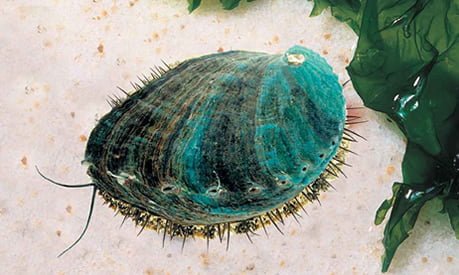
Abalone, a prized seafood in mariculture, faces a growing threat: rising water temperatures due to climate change. Environmental changes negatively impact the immunity and survival of abalone.
On the other hand, the intensification of aquaculture practices adds more complexity. Disease outbreaks and red tides cause significant economic losses to aquaculturists and hinder the industry’s growth.
Traditionally, antibiotics have been the preferred solution for disease prevention and treatment in aquaculture. However, this approach raises concerns about drug residues, antibiotic resistance, and environmental pollution, potentially harming human health throughout the food chain.
In this context, exploring ecological and natural alternatives such as breeding abalones tolerant to higher temperatures, abalones resistant to acidification, or using Chinese herbs emerges as a promising solution for sustainable abalone cultivation.
A study by scientists from the Ocean University of China delves into the unexplored territory of supplementing the diet of Haliotis discus hannai, also known as “green abalone” or “Japanese abalone,” with a mixture of Chinese herbs. The study examines the effects on growth, antioxidant capacity, immunity, and heat stress resistance.
Chinese Herbs
Chinese herbs and medicinal plants are rich in potent compounds such as flavonoids, alkaloids, and polysaccharides, offering a safer and more sustainable alternative. Their benefits are numerous, including:
- Growth promotion and appetite stimulation: Improves food utilization and leads to faster growth.
- Antioxidant activity: Combats oxidative stress and protects cells from damage.
- Stimulation of the immune system: Boosts defenses against diseases and environmental stressors.
- Anti-inflammatory and liver protection: Promotes overall health and resilience.
However, the potential of Chinese herbs lies not only in individual herbs but also in their synergy. The strategic combination creates a powerful cocktail of active ingredients, enhancing effectiveness compared to single-herb approaches.
Studies in fish species such as sobaity bream and Nile tilapia demonstrate the benefits of Chinese herbal combinations in terms of growth, immunity, and disease resistance, making them an important alternative for aquaculturists.
Combination of Medicinal Herbs
The study focused on five Chinese herbs:
- Artemisiae Scopariae Herba (Artemisia capillaris): Promotes growth, protects against oxidation and inflammation, and supports liver health.
- Gardeniae Fructus (Gardenia jasminoides): Liver protector and anti-inflammatory agent.
- Polygoni cuspidati rhizoma et radix (Polygonum cuspidatum): Possesses anti-inflammatory and anti-infectious properties.
- Uncariae Ramulus Cum Uncis (Uncaria rhynchophylla): Offers anti-inflammatory and antioxidant benefits.
- Scutellariae Radix (Scutellaria baicalensis): Exhibits antibacterial, anti-inflammatory, and anti-stress activities.
This research aimed to investigate the effects of supplementing abalones’ diet with Chinese herbs (CHM) on growth performance, antioxidant capacity, immunity, and heat stress resistance.
Benefits of Using Chinese Herbs
According to the study results, the main benefits of Chinese herbs for green abalone include:
- Superior growth: Abalone fed with 0.04% CHM experienced the highest weight gain, surpassing the control group.
- Stronger immunity: CHM increased digestive enzyme activity, antioxidant capacity, and lysozyme, a key immune molecule.
- Stress resilience: CHM reduced stress hormones like cortisol and glucose, preparing abalone for heat challenges. Abalone with CHM diets showed better survival rates and slower decline under heat stress.
- Gene activation: CHM positively regulated genes such as CAT1 (nutrient absorption) and NRF2 (antioxidant defense), while negatively regulating inflammatory genes like NF-κB and TNF-α.
Application in the Abalone Industry
The study’s findings lay the groundwork for incorporating Chinese medicinal herbs into abalone feed, paving the way for a more sustainable and resilient future for this valuable seafood.
Additionally, the study’s findings may pave the way for improving the health and resilience of cultivated abalone populations, reducing dependence on antibiotics, and promoting sustainable abalone farming.
Conclusion
Researchers found that the optimal dose of a Chinese herbal mixture for abalone was 0.049%. Further research can explore specific herb synergies and optimize formulations for different abalone species and conditions.
With increasing water temperatures and growing pressure on traditional disease prevention methods, CHMs offer a promising solution for the sustainable development of abalone aquaculture. By harnessing the power of these natural resources, we can promote healthy abalone populations and contribute to a more sustainable future for this valuable seafood.
The study was funded by the Innovation Ability Promotion Project of Science & Technology-type SMEs in Shandong Province, China.
Contact
Wenbing Zhang
The Key Laboratory of Aquaculture Nutrition and Feeds (Ministry of Agriculture and Rural Affairs), The Key Laboratory of Marine culture (Ministry of Education), Fisheries college, Ocean University of China, Qingdao 266003, China
Email: wzhang@ouc.edu.cn
Reference (open access)
Rui Wang, Hao Chen, Wenhao Fan, Panpan Yue, Hongyang Zhang, Peng Chen, Zhenhua Wu, Kangsen Mai, Wenbing Zhang. The growth performance, anti-oxidative capacity, immunity and resistance to heat stress of abalone Haliotis discus hannai can be improved by a mixture of herbs, Aquaculture Reports, Volume 35, 2024, 101931, ISSN 2352-5134, https://doi.org/10.1016/j.aqrep.2024.101931
Editor at the digital magazine AquaHoy. He holds a degree in Aquaculture Biology from the National University of Santa (UNS) and a Master’s degree in Science and Innovation Management from the Polytechnic University of Valencia, with postgraduate diplomas in Business Innovation and Innovation Management. He possesses extensive experience in the aquaculture and fisheries sector, having led the Fisheries Innovation Unit of the National Program for Innovation in Fisheries and Aquaculture (PNIPA). He has served as a senior consultant in technology watch, an innovation project formulator and advisor, and a lecturer at UNS. He is a member of the Peruvian College of Biologists and was recognized by the World Aquaculture Society (WAS) in 2016 for his contribution to aquaculture.
